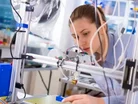How 3D printing transforms the healthcare industry

Behind recent advances in technology, 3D printing (or additive manufacturing) has moved to the forefront of healthcare evolution.
In today’s society, 3D printed jewelry, shoes, pens and even vehicles are available to purchase on the open market. The 3D-printing industry grew by 35.2 percent in 2014, and although there was a slight slowdown in 2015, its products are available in a wide range of industries.
RELATED TOPIC: How Australia is using 3D printing to improve cranial reconstruction
But the most appealing sector for 3D printing is healthcare, especially with the cost continuing to fall and the technology becoming more accessible.
Most healthcare technology is expensive when initially hitting the market before becoming cheaper over time. However, the majority of new 3D-printed products are accessible at a much more reasonable price.
As low manufacturing prices continue to fall, 3D printing makes customizations more realistic and makes formerly impossible treatments much easier to conduct.
RELATED TOPIC: 3D printing reshaping the Australian medical industry
This shift may disrupt the trend of rising medical care costs with a large aging population set to put added pressure on the healthcare system.
Part of the reason 3D-printed solutions are often cost-effective is the technology. The process involves building solid, three-dimensional objects from a digital model, using additive processes in which successive layers of material are assembled on top of one another to build the desired object.
This means items can be assembled directly from a digital model, increasing precision and removing room for error.
RELATED TOPIC: 3D printing gives new limbs to Sudan's 50,000 amputees
Many 3D-printed medical solutions are still in their experimental stages, but initial tests are promising in a variety of areas. Princeton University scientists have used 3D-printing tools to create a bionic ear that can hear radio frequencies far beyond the range of normal human capability.
Meanwhile there are plenty of other advances in the field of 3D bioprinting, and many of them have been a part of successful surgeries and treatments. It has made large strides in cancer treatment alone, as researchers developed a fast, inexpensive way to make facial prostheses for patients who had undergone surgery for eye cancer, using facial scanning software and 3D printing.
RELATED TOPIC: Brush Beam Improves Prototyping with 3D Printing
But medical 3D printing is not just for the most serious medical issues. In fact, it might become a part of mainstream medical practice to treat a wide range of people. 3D-printed ankle replacements, 3D-printed casts, and 3D-printed pills have all been developed in the past two years, with encouraging success rates.
Source: Harvard Business Review
Click here to read the latest edition of Healthcare Global magazine!
- Google Lens & GS1 Boost Healthcare TransparencyTechnology & AI
- How can AI Transform Recruiting in the Healthcare Sector?Technology & AI
- Alfa Laval Hopes New Center will Help Pharma InnovationSustainability
- Opella, Kimberly-Clark, Cencora: Top Stories in HealthcareProcurement & Supply Chain





